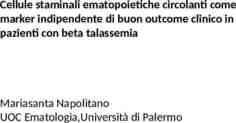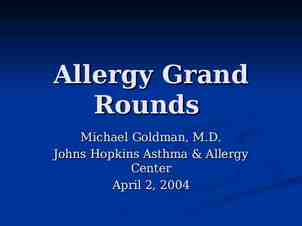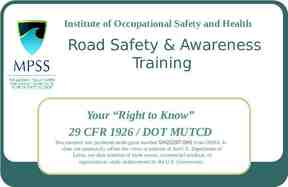Current Challenges in CardioMetabolic Testing Kenneth French,
29 Slides1.88 MB

Current Challenges in CardioMetabolic Testing Kenneth French, Director of Clinical Operations

Disclosers Employee at VAP Diagnostics Laboratory

Outline Cardiometabolic Disease: – Current Challenges and Methodology Limitations Advancements in Cardiovascular Risk Assessment Clinical Evidence and Guideline Recommendations Other markers to assess CVD risk

CVD is an Epidemic Cardiovascular Cardiovascular Disease Disease Metabolic Metabolic Disease Disease 1 in 3 US adults has 1 or more types of CVD11 Heart disease accounts for 25% of all US mortalities22 811,940 yearly deaths from CVD CVD kills more women each year than the next 3 causes of death combined33 Diabetes affects 25.8 million people of the US population Diabetes markedly increases the risk of MI, stroke, amputation, and death as a result of metabolic abnormalities44 At least 65% of people with diabetes die from some form of heart disease or stroke55 NCEP ATP III established diabetes as a CVD risk equivalent in mandating aggressive 4,6 antiatherosclerotic therapy4,6 NCEP ATP III National Cholesterol Education Program Adult Treatment Panel III. 1. Roger VL, et al. Circulation. 2011;123(4):e18-e209. 2. Gutstein DE, et al. Clin Pharmacol Ther. 2012;91(1). 3. WomenHeart. Available at: http://c.ymcdn.com/sites/www.womenheart.org/resource/ resmgr/docs/women, heart disease, and di.pdf. Accessed September 4, 2013. 1. 2. 3. Beckman JA, et al. JAMA. 2002;287(19). NDEP. Available at: http://ndep.nih.gov/media/CVD FactSheet.pdf. Accessed August 13, 2013. NCEP Adult Treatment Panel III. Circulation. 2002;106(25):3143-3421.

Why does CVD remain the number 1 Killer? Awareness? Medications? Identification?

Lack of Quality Diagnostics 50% of all people who experienced a cardiovascular events had recently received “normal” basic cholesterol result1 Basic Cholesterol Test (1973) Calculated LDL-C TC – HDL – TG(fasting)/5 1. Stamper MJ, Ridker PM, Dzau VJ. Risk factors criteria. Circulation. 2004;109(25 Suppl 1):IV3-5

Basic Cholesterol Testing Underestimates LDL-C Up to 60% in Patients An independent Study of 1.3 million patients conducted by Johns Hopkins Cardiology Note: this is over 2,900 times the size of the original publication that described Friedewald LDL-C estimation 10-20% of patients with normal triglyceride levels ( 150mg/dL) were reclassified as not meeting LDL-C goal 25-60% of patients with abnormal triglyceride levels ( 150mg/dL) were reclassified as not meeting LDL-C goal Martin SS, Blaha MJ, Elshazly MB, Brinton EA, Toth PP, McEvoy JW, et al. J Am Coll Cardiol. 2013;62(8):732-739.

Magnitude of Underestimation in Friedewald LDL-C Discordance in Friedewald and Direct LDL-C by TG Strata 59.4% 60 51.9% 50 Error (%) LDL-C 70-99 mg/dL 39.1 % 40 30 LDL-C 70 mg/dL 25.0% 20.3% 20 10.4% 10 n 8042 0 n 2678 100 mg/dL n 11,456 n 10,544 n 13,265 n 10,838 100-149 mg/dL 150-199 mg/dL Triglycerides n 24,988 n 19,677 200-399 mg/dL The basic lipid panel misclassifies patient goal attainment rates Martin SS, et al. J Am Coll Cardiol. 2013. *VLDL Very Large Database of Lipids

LDL-C Measurements Affect Treatment1 The basic lipid panel produces significantly underestimated LDL-C measurements.2,3 1. 2. 3. Lindsey CC, Graham MR, Johnston TP, Kiroff CG, Freshley A. Pharmacother. 2004;24(2):167-172. Expert Panel on Detection, Evaluation, and Treatment of High Blood Cholesterol in Adults. JAMA. 2001;285(19):2486-2497. Martin SS, Blaha MJ, Elshazly MB, Brinton EA, Toth PP, McEvoy JW, et al. J Am Coll Cardiol. 2013;62(8):732-739. Patients with elevated triglycerides frequently receive inaccurate LDL-C measurements

Underestimation of LDL-C Underestimation of Risk What if an LDL-C of 100mg/dL is actually 136mg/dL?

Summary of Basic Cholesterol Testing Limitations Developed by Friedewald in 19731 Basic Lipid Panel Underestimates LDL-C in 50% of Patients3 Underestimation Leads to False LDL-C Inaccurate in nonfasting state and/or when: Fasting 12 hours TG 150 mg/dL2-4 LDL-C 100 mg/dL4 Impact: Underestimation of LDL-C Leads to Underestimation of Risk 1. 2. 3. Problematic patients for Friedewald include5 Frederickson class I, III, or V hyperlipoproteinemia1 Diabetes, insulin resistance, or metabolic syndrome5 Liver disease5 Nephrotic syndrome or chronic renal insufficiency5 Hormone replacement6 Hypothyroidism5 Protease Inhibitors or other medications5 Progestins, anabolic steroids and corticosteroids Friedewald WT, et al. Clin Chem. 1972;18(6). Lindsey CC, et al. Pharmacotherapy. 2004;24(2). Martin SS, et al. J Am Coll Cardiol. 2013. 1. 2. 3. Scharnagl H, et al. Clin Chem Lab Med. 2001;39(5):426-431. NCEP ATP III. Circulation. 2002;106(25). Legault C, et al. J Clin Epidemiol. 1999;52(12).

Technologies to Assess Lipoprotein Risk VAP Diagnostics Laboratory – Vertical Auto Profile (VAP) Lipid Panel LabCorp – Nuclear Magnetic Resonance (NMR) LipoProfile Quest Diagnostics – Cardio IQ Ion Mobility Please visit these respective labs for more information about their services.

Why Understand Cholesterol/Lipoprotein Physiology? Current routine cholesterol assessment does not measure many of the known lipid parameters known to increase CVD risk Current Guidelines discuss lipoprotein components not measured routine cholesterol testing

2/3 of the story 1/3 of the story

Lipoprotein Physiology Directs Therapy Triglyceride Disorders Low Sugar Diet Control Insulin Resistance Diabetes control IR or ER Niacin Fenofibrate/Fenofibric acid Omega 3-Fatty Acids Cholesterol Disorders Low Sat Fat Diet Statins Ezetimibe Bile Acid Sequestrants Positive glycemic effect For Familial Hypercholesterolemia (FH) Mipomersen Lomitapide PCSK9 inhibitors

Why Granularity Matters Example of two patients: Patient 1 ApoB 130mg/dL LDL-P 1800nmol/L TC 220mg/dL HDL-C 45mg/dL Trigs 120mg/dL Therapy the same? Patient 2 ApoB 130mg/dL LDL-P 1800nmol/L TC 220mg/dL HDL-C 45mg/dL Trigs 120mg/dL

Why Granularity Matters – Treatment is Different Patient 1 ApoB 130mg/dL LDL-P 1800nmol/L TC 220mg/dL HDL-C 45mg/dL Trigs 120mg/dL Patient 2 ApoB 130mg/dL LDL-P 1800nmol/L TC 220mg/dL HDL-C 45mg/dL Trigs 120mg/dL Comprehensive Assessment Reveals: Patient 1 Patient 2 Elevated LDL-C Elevated LDL-C Elevated Remnant Lipoproteins Elevated Lp(a) Statin/Niacin or Statin/Fibrate Statin Only

Evidence-Based Guidelines Recommend Comprehensive Risk Factor Assessment LDL-C accounts for 30% of the risk of premature CVD, while the remaining 70% represents residual risk factors1 Residual risk can be attributed to LDL-C subclasses, remnant lipoproteins, and other HDL-C components2-4 Cardiometabolic risk stratification and personalized approach to management are recommended2-4 2-5 National National Guidelines Guidelines2-5 Direct Direct LDL-C LDL-C measurement measurement Secondary Secondary targets targets of of therapy therapy Non–HDL-C Non–HDL-C and and metabolic metabolic syndrome syndrome Emerging Emerging risk risk factors factors Lp(a), Lp(a), HDL-C HDL-C subclasses, subclasses, small small LDL LDL pattern, pattern, ApoB, ApoB, and and remnant remnant lipoproteins, lipoproteins, LDL-P LDL-P 1. 2. 3. Kreisberg RA, Oberman A. J Clin Endocrinol Metab. 2002;87(2). NCEP ATP III. Circulation. 2002;106(25). Brunzell JD, et al. Diabetes Care. 2008;31(4). 1. 2. Grundy SM, et al. Circulation. 2004;110(2). Jellinger PS, et al. Endocr Pract. 2012;18(suppl 1):

What to Consider When a Lab Choosing Cost of services and reimbursement Comprehensiveness of the test – How much information are you getting for one test verses ordering multiple tests? External Validation – Accuracy, precision, reproducibility Clinical significance – Publications, abstracts Guideline support – Information discussed in various guidelines Turn-around-time Ease of use in clinical practice

Other Labs to consider for CVD Assessment hsCRP – Chronic systemic inflammation LpPLA2 – Vascular specific inflammation Cystatin C – Kidney disfunction from normal through stage 2 GGT – Independent marker for Met. Syn. And CVD Homocysteine – Independent marker for Met. Syn. And CVD Multiple others

Consideration for other labs Outcome studies showing independent power over traditional risk factors Treatment protocols in place for managing excess risk Cost to healthcare/patient

Odd statistic The actual lab spend as a part of the overall healthcare expenditure (HCE) is low and accounts for 2.3% of the total healthcare cost. However, diagnostic testing guides approximately 66% of clinical decisions in cardiology and oncology.

Better Testing Leads to More Informed Treatment and Improved Outcomes Whether primary or secondary prevention, the goal is to prevent the event. Relying on standard labs has proven futile in the last few decades. Everything clinicians do depends on the information they have at their finger tips – Bad information in Bad Outcomes – Good information in Improved Outcomes

Thank you











